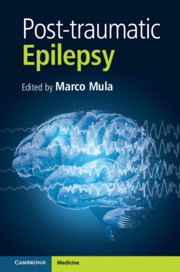Book contents
- Post-traumatic Epilepsy
- Post-traumatic Epilepsy
- Copyright page
- Contents
- Contributors
- Foreword
- Preface
- Chapter 1 Neurobiological Aspects of Post-traumatic Epilepsy: Lessons from Animal Models
- Chapter 2 Post-traumatic Epilepsy: Epidemiology, Definition and Terminology
- Chapter 3 Traumatic Brain Injury: The Acute Management and Prevention Programmes
- Chapter 4 Critical Care Management of Traumatic Brain Injury
- Chapter 5 Post-traumatic Epilepsy in Children
- Chapter 6 Sport-related Concussive Convulsions
- Chapter 7 Accidents and Injuries during Seizures
- Chapter 8 Cognitive Rehabilitation of Traumatic Brain Injury and Post-traumatic Epilepsy
- Chapter 9 Neuropsychiatric Consequences of Moderate to Severe Traumatic Brain Injury
- Chapter 10 Traumatic Brain Injury and Psychogenic Nonepileptic Seizures
- Chapter 11 Post-traumatic Epilepsy and Post-traumatic Stress Disorder
- Chapter 12 Antiepileptogenic Therapies for Post-traumatic Epilepsy: Is There Any Evidence?
- Chapter 13 Effects of Antiepileptic Drugs on Cognition
- Chapter 14 Post-traumatic Epilepsy in Low Income Countries
- Index
- References
Chapter 2 - Post-traumatic Epilepsy: Epidemiology, Definition and Terminology
Published online by Cambridge University Press: 10 August 2021
- Post-traumatic Epilepsy
- Post-traumatic Epilepsy
- Copyright page
- Contents
- Contributors
- Foreword
- Preface
- Chapter 1 Neurobiological Aspects of Post-traumatic Epilepsy: Lessons from Animal Models
- Chapter 2 Post-traumatic Epilepsy: Epidemiology, Definition and Terminology
- Chapter 3 Traumatic Brain Injury: The Acute Management and Prevention Programmes
- Chapter 4 Critical Care Management of Traumatic Brain Injury
- Chapter 5 Post-traumatic Epilepsy in Children
- Chapter 6 Sport-related Concussive Convulsions
- Chapter 7 Accidents and Injuries during Seizures
- Chapter 8 Cognitive Rehabilitation of Traumatic Brain Injury and Post-traumatic Epilepsy
- Chapter 9 Neuropsychiatric Consequences of Moderate to Severe Traumatic Brain Injury
- Chapter 10 Traumatic Brain Injury and Psychogenic Nonepileptic Seizures
- Chapter 11 Post-traumatic Epilepsy and Post-traumatic Stress Disorder
- Chapter 12 Antiepileptogenic Therapies for Post-traumatic Epilepsy: Is There Any Evidence?
- Chapter 13 Effects of Antiepileptic Drugs on Cognition
- Chapter 14 Post-traumatic Epilepsy in Low Income Countries
- Index
- References
Summary
Traumatic brain injury (TBI) is a major risk factor for the development of epilepsy, accounting for around 5% of all epilepsy cases. The risk is greatest within the first year of injury but persists for many years afterwards. Severity of injury is the biggest predictor of future risk of epilepsy, with evidence of intracerebral and sub-dural haemorrhage being important clinical indicators. Individual characteristics including medical co-morbidities and genetic predisposition also influence this risk.
TBI-related seizures are separated into those arising within the first week of injury (early post-traumatic seizures) and those happening later (late post-traumatic seizures). This distinction is useful because early post-traumatic seizures do not appear to be an independent risk factor for the future development of epilepsy. However, the risk of further seizures after a single late post-traumatic seizure is as high as 80%. Therefore, one late post-traumatic seizure signals an increased predisposition to generate future epileptic seizures. This fulfils the criteria for diagnosing epilepsy and the individual should be counselled and treated accordingly.
In this chapter, we discuss the classification of epilepsy and TBI severity before summarising the largest epidemiological studies that have attempted to ascertain the incidence and prevalence of post-traumatic epilepsy and the major risk factors.
- Type
- Chapter
- Information
- Post-traumatic Epilepsy , pp. 29 - 46Publisher: Cambridge University PressPrint publication year: 2021
References
- 1
- Cited by

